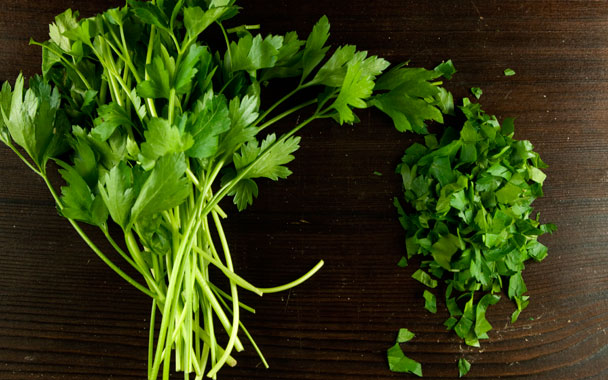One day early on in cooking school, Chef Fatigati announced the lesson: Today, we were going to learn how to chop parsley.
I’m paying tuition for this? Seriously? I mean, you take some parsley. You take a knife. The rest seems pretty self-explanatory.
He had us pick the leaves from the stem. We soaked them in some cold water. We gently rolled them up in a paper towel to dry. We spread them out on the cutting board in a certain way. We held our knives a certain way. We learned to rock our blades along the board in a certain way. Why all the fuss?
I cut the leaves, watching sharp lines form where my knife took the wild jagged shape of the parsley and gave it definite, stern angles. It looked pretty well chopped.
“Keep going!” Chef barked at me. Then, addressing the kitchen, he said, “Herbs release their flavor as they’re cut or bruised. Parsley is—I don’t know why this is—but parsley is unique in that you can mince it until it’s a powder and it will still stay bright green. All other herbs will turn black. Since it lets us take it that far, we take it that far.”
I kept going. Chopping, rocking, scraping it back together into a neat, flat pile on the board. Chop, rock, scrape. Chop, rock, scrape. “Why the hell are we doing this?” I muttered. I looked over at my neighbor’s station. He’d given up, his knife just kind of squirming along; loose, uncut parsley leaves dotted his board, mixing in with the finer stuff.
But once my irritation wore off, I noticed something. I couldn’t see those hard angles anymore. I couldn’t see the jagged shape of the parsley leaves. It all just looked like snow—brilliant, verdant snow.
Chef came over. “Now put that in some paper towel. Squeeze it out.” A few green drops came. Unrolling it, he took a pinch in his fingers and sprinkled it, dust-dry and powdery, onto a plate.
It looked amazing, and right away I got it. You can have so much control with this stuff, so much control over how much parsley you want in the dish, how evenly you want its flavor in each bite, how evenly you want its color on the plate. All minced up like this, you can dictate with precision the level of its presence.
I glanced at a still uncut bunch of parsley, whole and sandy. We didn’t just chop a pile of herbs. We transformed it, every step designed to get it to this point. You take the stems out because they don’t mince up as finely. You rinse in cold water to wash the grit off, but also to get the leaves cold and firm. You dry them so they separate. You spread them on the cutting board so that you cut evenly. Once you understand the reason behind every step of the process, you can understand the product.
It was resolutely French, this desire for refinement and control on the plate—later in the program, a chef teaching Italian cooking would yell at us for chopping the leaves in anything smaller than thirds. But it was bigger than regional or culinary style. The lesson for me was in taking the time to think about what we were doing, why you want to do something just so, why every step matters and is worth doing.




 Pinterest
Pinterest


